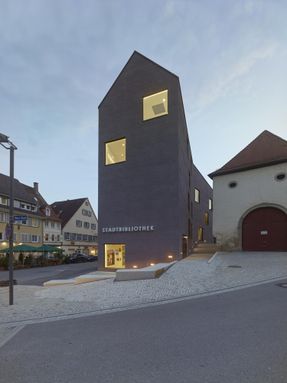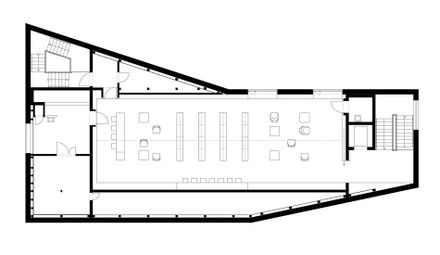
City Library Rottenburg
ARCHITECTS
Harris + Kurrle Architekten Bda
CITY
Rottenburg
COUNTRY
Germany
CONSTRUCTION MANAGEMENT
Göppel Strittmatter Hallig, Gesellschaft von Architekten mbH
STRUCTURAL ENGINEER
Engelsmann Peters
BUILDING SERVICES PLANNING
Heimann Ingenieure GmbH, Lorsch
BUILDING PHYSICS PLANNING
TEB GmbH, Vaihingen/Enz
CLIENT
Hochbauamt
FIRE PROTECTION PLANNING
Planungsgruppe Kuhn GmbH & Co.KG, Sindelfingen
KITCHEN PLANNING
Edgar Fuchs GmbH
LANDSCAPE ARCHITECT
Schmid | Treiber | Partner Freie Landschaftsarchitekten, BDLA, IFLA, Leonberg
YEAR
2017
LEAD ARCHITECTS
Bertram Wruck, Vojtech Bast, Florian Foetsch, Kristina Herberg, Mirko Schaab
MANUFACTURERS
Sto, TECU®, Interpane, Schüco, Wienerberger, Facade system, Load-bearing outer wall, Roof covering, Window glass, Window profile system
Text description provided by architect.
The new town library is built in the town centre, between the medieval town centre and the Episcopal palace, serving on this prominent site as a new public meeting place.
The result is a communicative building in the urban fabric. Communication meaning, on this urban-spatial level, that topics of the environment are recorded, interpreted and re-rendered. So something new emerges whose “genetic code” is drawn from the environment.
The building form for the city library was developed from the cranked form of the neighbouring buildings. This creates a spatial dialogue. The library is located at the interface of very different scales.
The varying eaves heights of the new building - due to the straight pitched roof on the cranked building plan transfers between the grandeur of the Episcopal Palace and lower buildings of the old town.
The entrance level, with generous reception desk, is about public communication and is characterised by its maximum openness.
An open house for the citizens of the city with a cafe that can also be used for events in the evening. The upper floors are available to the public for reading and learning.
The extensive walls are largely covered with library shelves. These are interrupted by large windows with deep reveals, which are suitable for sitting and reading.
The readers in the windows become visible from the outside, proclaiming the function of the building into the public space.














